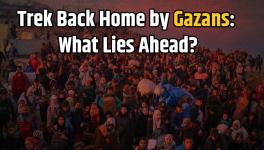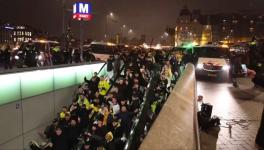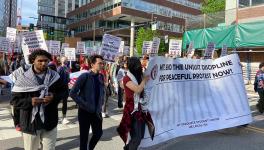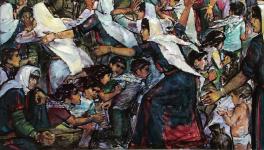A Reality Check for the Paris Initiative
The Israeli Bantustanization project is an attempt to reduce the areas accessible to Palestinians to fragmented cantons - or Bantustans - and annex the remaining land and natural resources, using the term 'Bantustan' as was applied to partially self-governing areas under South Africa’s white supremacist apartheid system. So far, "peace initiatives", like the planned conference that started in Paris this week, haven’t exactly helped in stalling this process.
The borders for the 'Bantustans' were defined during the bilateral Israeli-Palestinian Oslo negotiations in 1993 that followed the international Madrid conference. At that time, 60% of the West Bank lands had been categorised as Area C, under full Israeli control. This sparked a dramatic increase in home demolitions. In the present situation, Area C also provides a regulatory mechanism for Israel to expropriate Palestinian lands and expand illegal settlements, including the removal of Palestinians. The beginning of the construction of the Separation Wall, which runs roughly along the boundaries to Area C was accompanied by another wave of home demolitions to clear the area behind the wall. The current peak in demolitions had already started in 2013, in conjunction with the launch of US Secretary of State John Kerry’s US Initiative for Israel and Palestine.
The Paris initiative aims to restart negotiations for a two-state solution. But so far peace plans have only helped Israel take more Palestinian land
Completely ignoring international peace initiatives, Israel continues to implement its decades old plans. In 2011, Israel informed UN agencies of the plan to displace dozens of Palestinian communities in the occupied West Bank. It is moving to wipe out 46 Bedouin communities and its policies and practices are targeting the existence of the almost 300,000 Palestinians living in 532 communities in the rural parts of the occupied West Bank. These numbers remind us of the Nakba, our catastrophe, when over 500 Palestinian communities were destroyed in 1948/9 in order to allow the creation of the state of Israel with a Jewish majority on 78% of what was historic Palestine. The forceful expulsions of Palestinians aim to further reduce access for Palestinians to only 13% of our ancestral lands.
Israel uses military incursions, settler violence, the closing off of areas for military purposes, denial of access to water and basic services and, above all, house demolitions in its efforts to clear Palestinians off their land. In the first three months of 2016, Israel has carried out more demolitions than all of 2015. Over 11,000 outstanding demolition orders threaten the homes or livelihoods of some 10,000 Palestinian families. Targeted areas are normally those close to settlements or Israeli-only roads so as to substitute the Palestinian community with Israeli settlers. The network of Israeli-only roads connect settlements with each other and to Israeli cities outside the West Bank and further limit movement and access to resources for Palestinians.
Palestinian communities in Area C need to obtain building permits from the Israeli Authorities, a nearly impossible feat. Since 2000, 95% of the applications for building permits submitted by Palestinians in have been rejected. In 99% of Area C Palestinian construction is prohibited or highly restricted. Lack of "building permit" just like "military trainings" and simply "security reasons" result in demolition orders of Palestinian homes, schools, water systems, animal shelters, roads and entire villages. Communities built generations ago are now accused of existing outside the Israeli urban "masterplan" and hence are to be wiped out.
Many of the 46 Palestinian Bedouin communities at risk of being wiped off the map are in the Jordan Valley, a stretch of land Israel needs to dominate to secure territorial control from the Mediterranean to the Jordan River and definitively end the two-state solution. The village of Al Hadidiya, for example, illustrates how the theft of natural resources and the demolition of Palestinian homes contributes to the growth of Israeli settlements. Al Hadidiya has been repeatedly destroyed since the establishment of Roi, the first Israeli settlement in the area in the 1970s. Demolitions are carried out in the hardest times of the year, either in the hot summer or freezing winter. After Israeli military bulldozers entered the village on 25 November, 2015 to demolish their homes once again, the families had to sleep out in the cold and rain for weeks, until the court issued a permit allowing them to erect temporary tents. The Israeli policy of demolition orders goes hand in hand with the proliferation of settlements in the area and the pillage of Palestinian natural resources. Al Hadidiya residents have lost their homes and are now barred from using their water well in order to channel water to the Roi settlement, where settlers have established a fish breeding business. At the moment, the only way to get water is to drive 40 km, passing via several military checkpoints and at an expense of 100 NIS each time. The message of forced displacement is clear.
Israel has created the "Relocation Plan" to deal with the evicted communities. The plan allocates land confiscated from other Palestinian villages in order to build townships for the displaced Palestinian Bedouin communities. But the forced move to townships will mean that they leave their lands and livelihoods behind, thus impoverishing the communities and increasing aid dependency. Once depopulated, the memory of Palestinian existence is to be erased as nearby settlements, just as during the 1948/9 ethnic cleansing wave, are already holding almost identical names to the destroyed villages. This is the case of the Bedouin community of Susiya, under continued threat of extinction since the establishment of the Israeli settlement of Susya.
These policies, carried out over decades in complete violation of international law and Palestinian rights, have ensured that of the population of Palestinians living in what is now Area C has declined drastically, from 350,000 in 1967 to a mere 150,000 today. Many of the families remaining must struggle with the trauma of continued home demolitions as well as a sense of vulnerability that is intended to breed feelings of insecurity and impotence that will finally push them to leave their lands.
The over 500 communities in Area C should be on top of the agenda of the leaders gathering in Paris. They are key in the effort to stop the Israeli Bantustanization and the slow ethnic cleansing of our people. The communities in Area C are building networks of popular resistance, such as the Popular Council of the Jordan Valley, and organize protests, the rebuilding of homes and communities and other activities to support the resilience of the communities.
Has the international community learned its lessons from the past? Or will it once again fail the Palestinian people by proposing yet another round of futile negotiations that will give Israel just enough time to finalize our Bantustanization? It is 10 years since Palestinian civil society issued a call for boycotts, divestments and sanctions, a move taken because we know Israel will only stop when it loses its international financiers and stops reaping profits from its crimes. But it seems decision makers around the world still do not know what actions are needed to stop the Bantustanization of Palestine.
-Jamal Juma is coordinator of the Palestinian Grassroots Anti-Apartheid Wall Campaign and the Land Defense Coalition.
Courtesy middleeasteye.net
The opinions expressed in this article are those of the author and do not necessarily reflect the editorial position of Middle East Eye.
Photo: US Secretary of State John Kerry (C) speaks with European Union High Representative for Foreign Affairs Federica Mogherini (R) during an international and interministerial meeting in a bid to revive the Israeli-Palestinian peace process in Paris on 3 June, 2016 (AFP).
Disclaimer: The views expressed here are the author's personal views, and do not necessarily represent the views of Newsclick
Get the latest reports & analysis with people's perspective on Protests, movements & deep analytical videos, discussions of the current affairs in your Telegram app. Subscribe to NewsClick's Telegram channel & get Real-Time updates on stories, as they get published on our website.






















